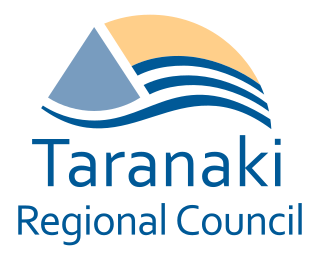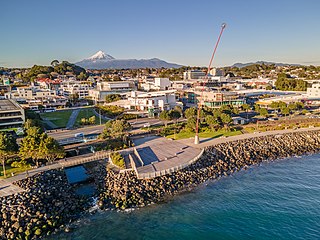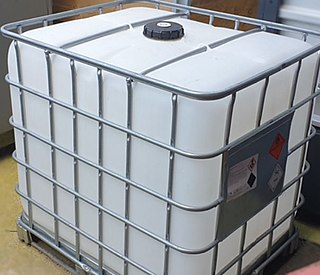
Taranaki is a region in the west of New Zealand's North Island. It is named after its main geographical feature, the stratovolcano Mount Taranaki, also known as Mount Egmont.

New Plymouth is the major city of the Taranaki region on the west coast of the North Island of New Zealand. It is named after the English city of Plymouth, in Devon, from where the first English settlers to New Plymouth migrated. The New Plymouth District, which includes New Plymouth City and several smaller towns, is the 10th largest district in New Zealand, and has a population of 88,900 – about two-thirds of the total population of the Taranaki Region and 1.7% of New Zealand's population. This includes New Plymouth City (59,600), Waitara (7,550), Inglewood (3,870), Ōakura (1,730), Ōkato (561) and Urenui (429).

Think Big was an interventionist state economic strategy of the Third National Government of New Zealand, promoted by the Prime Minister Robert Muldoon (1975–1984) and his National government in the early 1980s. The Think Big schemes saw the government borrow heavily overseas, running up a large external deficit, and using the funds for large-scale industrial projects. Petrochemical and energy related projects figured prominently, designed to utilise New Zealand's abundant natural gas to produce ammonia, urea fertiliser, methanol and petrol.
Methanol fuel is an alternative biofuel for internal combustion and other engines, either in combination with gasoline or independently. Methanol (CH3OH) is less expensive to sustainably produce than ethanol fuel, although it is more toxic than ethanol and has a lower energy density than gasoline. Methanol is safer for the environment than gasoline, is an anti-freeze agent, prevents dirt and grime buildup within the engine, has a higher ignition temperature, and produces horsepower equivalent to that of super high-octane gasoline. It can readily be used in most modern engines. To prevent vapor lock due to being a simple, pure fuel, a small percentage of other fuel or certain additives can be included. Methanol may be made from fossil fuels or renewable resources, in particular natural gas and coal, or biomass respectively. In the case of the latter, it can be synthesized from CO2 (carbon dioxide) and hydrogen. The vast majority of methanol produced globally is currently made with gas and coal. However, projects, investments, and the production of green-methanol has risen steadily into 2023. Methanol fuel is currently used by racing cars in many countries and has seen increasing adoption by the maritime industry.

Waitara is a town in the northern part of the Taranaki region of the North Island of New Zealand. Waitara is located just off State Highway 3, 15 kilometres (9.3 mi) northeast of New Plymouth.

The Maui natural gas field is the largest gas, natural gas condensate and oil field in New Zealand, producing nearly three-quarters of the country's hydrocarbons, as well as providing energy for electricity generation. It is located in the Tasman Sea, 35 km off the coast of Taranaki and to the southwest of New Plymouth. It covers an area of 157 square kilometres and is located in 110 metres of water.

The methanol economy is a suggested future economy in which methanol and dimethyl ether replace fossil fuels as a means of energy storage, ground transportation fuel, and raw material for synthetic hydrocarbons and their products. It offers an alternative to the proposed hydrogen economy or ethanol economy, although these concepts are not exclusive. Methanol can be produced from a variety of sources including fossil fuels as well as agricultural products and municipal waste, wood and varied biomass. It can also be made from chemical recycling of carbon dioxide.

Synthetic fuel or synfuel is a liquid fuel, or sometimes gaseous fuel, obtained from syngas, a mixture of carbon monoxide and hydrogen, in which the syngas was derived from gasification of solid feedstocks such as coal or biomass or by reforming of natural gas.

Gas to liquids (GTL) is a refinery process to convert natural gas or other gaseous hydrocarbons into longer-chain hydrocarbons, such as gasoline or diesel fuel. Methane-rich gases are converted into liquid synthetic fuels. Two general strategies exist: (i) direct partial combustion of methane to methanol and (ii) Fischer–Tropsch-like processes that convert carbon monoxide and hydrogen into hydrocarbons. Strategy ii is followed by diverse methods to convert the hydrogen-carbon monoxide mixtures to liquids. Direct partial combustion has been demonstrated in nature but not replicated commercially. Technologies reliant on partial combustion have been commercialized mainly in regions where natural gas is inexpensive.

Sir Māui Wiremu Pita Naera Pōmare was a New Zealand medical doctor and politician, being counted among the more prominent Māori political figures. He is particularly known for his efforts to improve Māori health and living conditions. However, Pōmare's career was not without controversy: he negotiated the effective removal of the last of Taranaki Māori land from its native inhabitants – some 18,000 acres – in a move which has been described as the "final disaster" for his people. He was a member of the Ngati Mutunga iwi originally from North Taranaki; then Wellington, and the Chatham Islands after their 1835 invasion.
The Todd Corporation is a large private New Zealand company with a value of $4.3 billion, owned and controlled by the Todd family and headquartered in Wellington, New Zealand. The corporation is currently led by board chair, Nick Olson, and group chief executive officer, Evan Davies. The corporation employs 800 individuals at 10 locations in New Zealand, Australia, and Canada including four on the executive team. The board of directors has seven members.

The New Plymouth Power Station (NPPS) was a 600 MW thermal power station at New Plymouth, New Zealand. Located at Port Taranaki, it was dual fuelled on natural gas and fuel oil. Constructed at a time of major hydro and HV transmission developments, it was New Zealand's first big thermal power station planned for continuous base load operation.

The Pohokura field is an oil and gas field located 4 km offshore of north Taranaki in New Zealand, in approximately 30 m of water. The field was discovered in 2000 by Fletcher Challenge and has ultimate recoverable reserves (1P) of 1,227 billion cubic feet or 1435 PJ of gas and 61 million barrels of oil and condensate.

The oil and gas industry in New Zealand explores and develops oil and gas fields, and produces and distributes petroleum products and natural gas.
Greymouth Petroleum is an energy company in New Zealand, established in 2002. It owns gas and oil fields, principally in onshore Taranaki, including Kowhai and Turangi in the north of the basin, and smaller fields such as Ngatoro and Kaimiro to the south, mainly delivering gas into industrial customers served by the Maui pipeline as well as Methanex locally. In 2002 it acquired the Kaimiro and Ngatoro fields from Shell Energy. In 2008 it acquired the New Zealand assets of Swift Energy. In 2018, it lodged a court challenge to the New Zealand government's ban on issuing new offshore oil and gas exploration permits.

Methanex Corporation is a Canadian company that supplies, distributes and markets methanol worldwide.
Sir Bryan James Todd was one of four brothers who built one of New Zealand's biggest industrial and commercial enterprises. He was an important figure in the development of the New Zealand oil and gas energy industry and, incidentally, in the development of New Zealand tax law.
The petroleum industry in India dates back to 1889 when the first oil deposits in the country were discovered near the town of Digboi in the state of Assam. The natural gas industry in India began in the 1960s with the discovery of gas fields in Assam and Maharashtra. As on 31 March 2018, India had estimated crude oil reserves of 594.49 million metric tonnes (Mt) and natural gas reserves of 1339.57 billion cubic metres of natural gas (BCM).
Kapuni is an onshore natural gas-condensate field located in the Taranaki Basin, a ~100,000 km2 partially-inverted rift basin on the Taranaki Peninsula in the North Island, New Zealand. Discovered in 1959 and brought into production in 1970, Kapuni remained New Zealand's only producing gas-condensate field until the offshore Maui gas field began production in 1979.
Manufacturing in New Zealand contributed $23 billion (12%) of the country's gross domestic product and directly employed 241,000 people in 2017, while manufactured goods made up 52% of the country's exports by value. The food and beverage subsector alone contributed 32% of manufacturing's GDP and 71% of exports.













